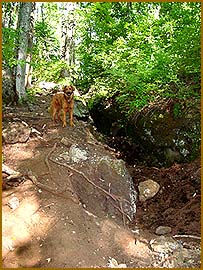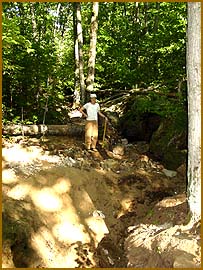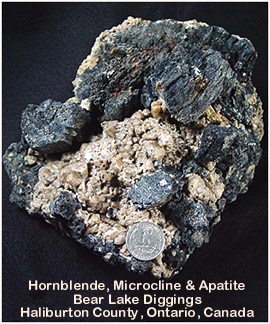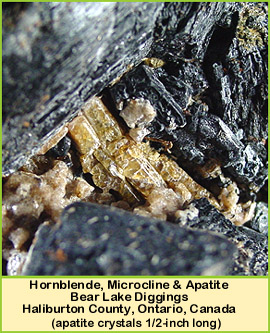Bancroft Area Collecting
Ontario, Canada
August 15-19, 2005
By Mike Streeter
mcstreeter@charter.net
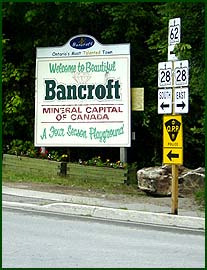
After talking for years about making a trek up to collect in the world-famous
Bancroft area, the heat of another North Carolina summer made easy Chrissy's and my decision to drive North
into the heart of Ontario, Canada. Bancroft is renowned for an incredible variety of rocks and
minerals that can be collected in a relatively small area.
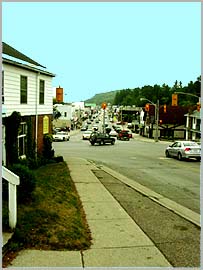
We arrived in Bancroft late afternoon on Monday, August 15th. Having heard
from friends that the town was a small and sleepy, we were somewhat surprised by its actual
decent size and with how busy it was with lots of cars and people bustling about. We would find
out that the population of Bancroft swells to almost three times its winter size as it fills with
tourists from the cities to the south, especially from the Toronto area. The many lakes, rivers,
old mines and prospects supply endless recreational opportunities to boaters, fishermen and
rockhounds.
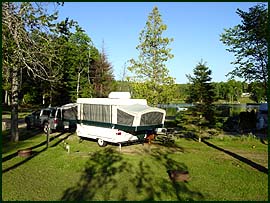
We had made prior arrangements to stay at the Bancroft Tent and Trailer Camp in
our folding camping trailer. I had found the site on the NET and hoped for the best. When we
arrived at the campground located a few miles south of Bancroft, we were pleased to find that
our reserved spot had a wonderful view of Marble Lake. However, we did have to tough out the fact that
there was no cable television, but we did receive one Toronto station so that we would, at least, be
able to stay abreast of the weather reports. For some reason, there seemed to be a lot of "bears in
the backyard" reports and many others about off-season hockey trades.

We awoke early on a beautiful Tuesday morning to the sounds of geese on the lake.
Our game plan for the day was to go to the Bear Lake diggings. We had stopped in at the Bancroft
Chamber of Commerce the day before to obtain our permits to dig there. Five dollars per person
seemed like quite a bargain for such a famous and potentially rewarding location. While planning
the trip, I had decided to visit seven different collecting locations and going to Bear Lake first
was fitting as we had heard that just about all rockhounds new to the area head there first as well.
During my preparation for the trip, I created the following area map that would help keep us oriented
in a general sense as we traveled from site to site.
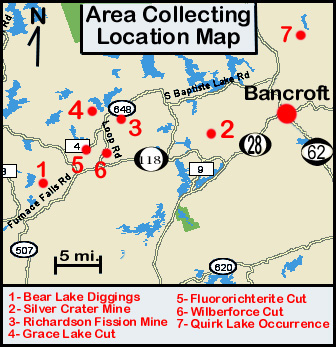
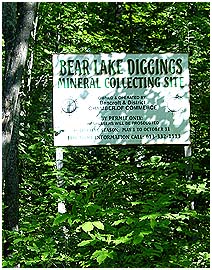
We drove out to the Bear Lake site located about 40 miles west of Bancroft. The
mosquitoes were there waiting for us when we got out of the truck and started gearing up, but they pretty
much left us alone after a swabbing of 100% deet liquid. We had heard lots of horror stories of
about how bad the area mosquitoes and black, deer and horse flies were, but none ended up presenting
much of a problem at all. I guess the dry summer coupled with the already cool overnight temperatures
had lessened the volume of pesky bugs.
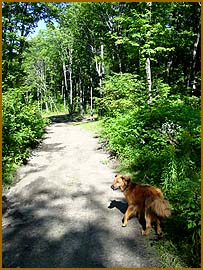
We made our way to the digging area just off the road and parking area. There was
no question where digging had taken place, as there were huge holes and piles of dirt over a wide area
beneath the forest canopy. A series of parallel "fissures" run in a generally north-south direction.
These so-called fissures are actually what remains of large calcite veins after much of the calcite
has been weathered away from infiltrating acidic groundwater. The fissures at Bear Lake are known to
contain very large fluorapatite crystals, hornblende, feldspar, biotite and titanite. Some of the
minerals are loose in soil produced by weathering, while others may be found imbedded in calcite.
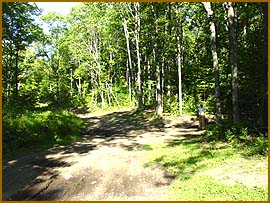
We searched the area for a likely place to dig and ended up concentrating on a
fissure nearest the top of the hill. Not really knowing exactly what to do, I started digging
in an area where it appeared that someone else had dug. Whenever in doubt at a new place, I will
usually dig in a place that appears to have been freshly dug and where someone has done
some obvious high-grading. This method doesn't always work but at least it allows me to get a feel
for what's underground. Chrissy sniffed out her own location and began scratching around looking
for some goodies.
I could see where many of the fissures extended many feet below ground; like
narrow dark caves that require lights and a lack of claustrophobia. I've never been much for
crawling down into deep holes, so I left these alone and concentrated on creating a few of my own
big open holes.
For whatever reason, I started digging in an area above a small fissure. Before
long, I had punched my way into a pocket that was partially filled with excellent feldspar clusters.
Some of the clusters contained small fluorapatite and large weathered hornblende crystals.
Report continued . . . . . . .
Click Here for Next Page
